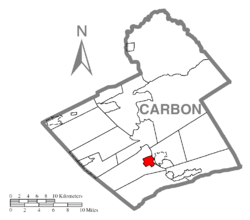Lehighton, Pennsylvania
| Lehighton, Pennsylvania | |
|---|---|
| Borough | |

Lehighton, Pennsylvania
|
|
 Location of Lehighton in Carbon County |
|
| Location of Lehighton in Pennsylvania | |
| Coordinates: 40°49′55″N 75°42′53″W / 40.83194°N 75.71472°WCoordinates: 40°49′55″N 75°42′53″W / 40.83194°N 75.71472°W | |
| Country | United States |
| State | Pennsylvania |
| County | Carbon |
| Government | |
| • Mayor | William Bauchspies |
| Area | |
| • Total | 1.65 sq mi (4.3 km2) |
| • Land | 1.62 sq mi (4.2 km2) |
| • Water | 0.03 sq mi (0.08 km2) |
| Elevation | 570 ft (170 m) |
| Population (2013 est.) | |
| • Total | 15,414 |
| • Density | 9,300/sq mi (3,600/km2) |
| Time zone | EST (UTC-5) |
| • Summer (DST) | EDT (UTC-4) |
| ZIP code | 18235 |
| Area code(s) | 610 Exchanges: 377,379 |
| Website | www |
Lehighton (/li'hɑitən/) is a borough in Carbon County, Pennsylvania, United States, 77 miles (124 km) north of Philadelphia, and 54 miles (87 km) south of Scranton. In the past, it developed early industries because of water power from the Lehigh River. With the location of a repair facility here and its regional operations, the Lehigh Valley Railroad became for years a major employer of thousands of people from the area. Post-World War II railroad and industry restructuring led to job and population losses.
From a peak of nearly 7,000 in 1940, the population was 5,500 at the 2010 census. Lehighton is the most populous borough in Carbon County and still the business hub of the county.
At the time of the first European's encounters with historic American Indian tribes, this area was part of the shared hunting territory of the Iroquoian Susquehannock and the Algonquian Lenape (also called the Delaware, after their language and territory along the Delaware River) peoples, who were often at odds. Relatives of the peoples of New England and along the St. Lawrence valley of Canada, the Delaware bands occupied much of the coastal mid-Atlantic area in Delaware, New Jersey, Eastern Pennsylvania and lower eastern New York, including Long Island. The Susquehannock confederacy's homelands were mainly along the Susquehanna River, from the Mohawk Valley in lower New York southerly to the Chesapeake and Virginia's Shenandoah Valley, but may have ranged into the 'empty lands' of West Virginia, Eastern Ohio, and Western Pennsylvania. The Dutch and Swedes first settled the Delaware Valley, and found the area north of the Lehigh Gap to be lightly occupied, probably by transients, but traveled regularly by the Susquehannock. This tribe traveled quite a bit according to the American Heritage Book of Indians, including being described in lofty terms by John Smith when a band visited the new Jamestown, Virginia colony. In the decades of the Beaver Wars in the mid-1600s, the Susquehannocks conquered and made the Lenape a tributary tribe — and also nearly inflicted an overwhelming defeat on the powerful Iroquois Confederacy,. Shortly thereafter, the Susquehannocks suffered a reversal, falling first to epidemic disease that raged for three years which killed off potentially 90% of their population, and a series of battles on most of their frontiers as various enemies took advantage. This vacated the southeastern and central Pennsylvania regions for the Delaware peoples. However, all tribes were thereafter displaced westwards by continued colonial growth. Delaware dominance at the time of European colonization is why William Penn's settlers adopted Lenape Lenki (Delaware) names for landscape features, and less than a handful of Susquehannock names.
...
Wikipedia

